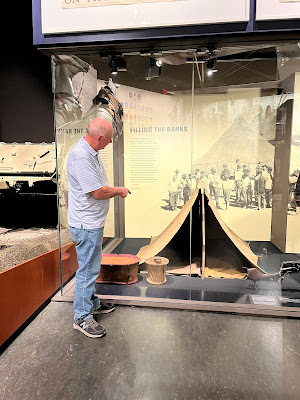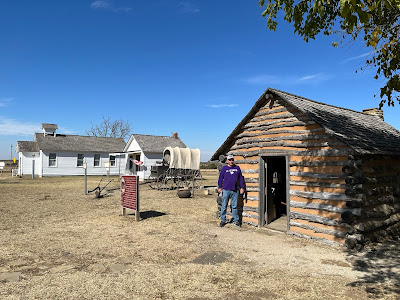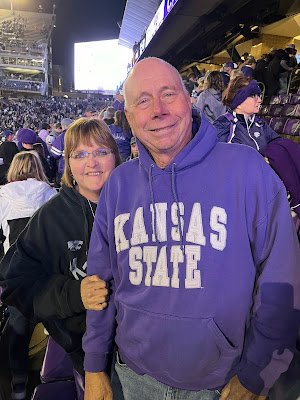
BOOKENDS: Every trip has a start point and an end point. Of course, if you have stronger "constitutions" than we old people do these days, there don't have to be as many way-stations along the way. But our trip to and from Eureka Springs had some tourist stops on both ends of the journey.
BEGINNING BOOKEND
When I was a little girl, one of my favorite TV shows was "Bewitched." I often daydreamed about how convenient it would be to "wiggle my nose" like Samantha and instantaneously get the result I wanted.
Alas, it doesn't work any better now than it did when I was a kid. So, when you depart for a trip, you know it's going to take you a certain amount of time to get there. When you live with a map aficionado like Randy, he definitely develops a time table and plan.
Randy figured our departure time would have us arrive in southeast Kansas around noon.When it's nice weather, we often take a sandwich lunch in a cooler for
our noon meal, rather than stopping at a fast food place along the way.He proposed stopping again at Big Brutus, where we'd had a picnic lunch on our spring 2023 trip through Missouri, Illinois, Kentucky, Indiana and back home again.
On one of our excursions through that part of the state, I'd seen that there was a Little House on the Prairie Museum. So I suggested a new stop instead. The museum near Independence, KS, celebrates the setting for Wilder's "Little House on the Prairie" book.
My mom read the "Little House" books to we three girls, and I re-read them myself later in elementary school - twice, if I recall. Both Jill and Kinley read some of them, too. During the earlier 2023 trip, we'd stopped at Mansfield, Mo., when I happened to see a billboard advertising a
Laura Ingalls Wilder museum there. While the Kansas version wasn't as extensive as the Mansfield site, I still enjoyed it, and there were even picnic tables there to enjoy our lunch.
The log cabin resembles one described as the Ingalls' home in "Little House on the Prairie," though this is a reproduction. The Osage signed the treaty selling the land to the government on September 10, 1870. The family home was listed as the 89th residence of Rutland township in the 1870 U.S. Census, and the family lived there about one year. In her book, Laura told of building the cabin, of encounters with Indians, of going to Independence for supplies and of Dr. Tann's treating the family members for "fever'n'ague." Dr. Tann's grave is in Mount Hope Cemetery in Independence. The family Bible reveals that Caroline "Carrie" Ingalls was born in Rutland township in Montgomery County, Kansas, in August 1870.

There is an old farmhouse on the site, but the Ingalls family never lived in the house. It's just a representation of how people who settled in the region may have built more permanent housing if they were in Kansas to stay. The Ingalls family only lived in the area about a year before returning to Wisconsin.

A gift shop is now in the farmhouse.

The hand-dug well on site, dug by Charles Ingalls, is mentioned in Laura's book.

Also on site are the Wayside, Kansas, post office ...

... and the Wayside School.
It was a nice stop along the way ... even Randy enjoyed it (though probably not as much as I did).
ENDING BOOKEND

We stopped to see Brent and Susan in Kansas City on our way home. While they finished up their day of work, we did a "tourist-y" thing and went to the Kansas City World War I museum. We'd been to a concert on the grounds, and we'd seen the museum from the outside. For this trip, we took the time to tour it.
The displays were excellent. At the time we were there, they were working on a display that would feature tanks used in warfare. We'll have to go back another time, since Randy's dad drove a tank during the Korean War. (It was scheduled to reopen on Veteran's Day, so if you're planning a trip to Kansas City during Christmas break, it should be open.)

However, there was a bit of nostalgia with another of the displays. Randy remembers a tent similar to the one above that they unearthed at his Grandma Ritts' house. It had probably belonged to her brother, Ray, whom she'd cared for. Randy and Lyle took it home and had a grand time setting up the tent and playing Army at the farmstead.
Soon after World War I ended, Kansas City leaders formed the Liberty
Memorial Association (LMA) to create a lasting monument to the men and
women who had served in the war. In 1919, the LMA and citizens of Kansas
City raised more than $2.5 million in just 10 days. The equivalent of
more than $40 million today, this accomplishment reflected
the passion of public sentiment for the Great War that had dramatically
changed the world.
“It [The Liberty Memorial] has not been raised to commemorate war
and victory, but rather the results of war and victory which are
embodied in peace and liberty…. Today I return in order that I may place
the official sanction of the national government upon one of the most
elaborate and impressive memorials that adorn our country. The magnitude
of this memorial, and the broad base of popular support on which it
rests, can scarcely fail to excite national wonder and admiration.”
— Liberty Memorial Dedication Speech, President Calvin Coolidge, November 11, 1926
All the displays were well-done and gave plenty of opportunities to read
as much or as little as you wanted. Plus, there were films interspersed
throughout, giving ample chances to sit, rest and learn something at
the same time.

Over time, the physical structure of the original Liberty Memorial
deteriorated, and it was closed in 1994 due to safety concerns. However, in 1998, Kansas City citizens passed a limited-run sales tax to support
the restoration to better showcase the
WWI-related objects and documents the LMA had been collecting since
1920. In 2004, the Museum and Memorial was designated by Congress as the
nation's official World War I Museum, and construction started on a new
80,000-square-foot, state-of-the-art museum and the Edward Jones
Research Center underneath the Liberty Memorial.The Liberty Memorial was designated a National Historic Landmark on
Sept. 20, 2006, recognizing the monument as a nationally significant
historic property.
JUST ONE MORE STOP

Final stop on our travel itinerary was a home football game at K-State. Susan and Brent joined us.
The late start time made for a beautiful sky to begin the evening.
There were fireworks after beating KU, 29-27. Unfortunately, the late start meant a middle-of-the-night return
home. A victory always makes the drive a
little more pleasant.

















































